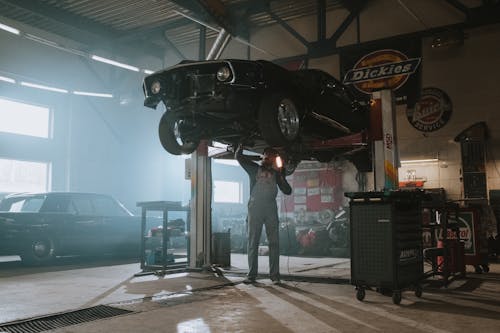Vehicle inspection history is a record of all inspections, maintenance, and repairs performed on a vehicle over time. It includes:
- Pre-trip and post-trip inspections
- Routine maintenance schedules
- Repair history and part replacements
- Odometer readings and mileage logs
- Compliance and safety checks
Keeping an organized vehicle inspection history improves fleet reliability and helps prevent unexpected failures on the road.
Why is Vehicle Inspection History Important?
Maintaining a detailed vehicle inspection history ensures fleet safety, cost efficiency, and regulatory compliance. Key benefits include:

Reduces Accidents and Breakdowns
Regular inspections help detect mechanical issues before they lead to failures. For example, brake wear, tire damage, and engine problems can be fixed early, preventing dangerous road incidents.
Enhances Driver Safety
Drivers need assurance that their vehicles are safe to operate. When a fleet’s inspection history is updated and accessible, drivers can verify vehicle condition before every trip.
Ensures Compliance with Federal Regulations
The FMCSA (Federal Motor Carrier Safety Administration) mandates that fleet operators maintain proper vehicle inspection records under CFR §396.13. Failure to comply can result in hefty fines and legal liability.
Reduces Maintenance Costs
Fleet maintenance is cheaper when minor issues are fixed early. Regular inspections prevent expensive repairs and emergency breakdowns.
Improves Fuel Efficiency
A well-maintained vehicle runs more efficiently. Inspection history helps monitor fuel-related parts, tire pressure, and engine performance, reducing fuel waste.
Boosts Fleet Reputation
Shippers and clients prefer fleets with strong safety records. Keeping transparent inspection reports builds trust and enhances business credibility.
How to Improve Fleet Safety Using Vehicle Inspection History

Fleet safety improves when inspection history is properly documented and used for decision-making. Follow these steps:
Implement a Digital Inspection System
Using fleet management software to track inspections ensures accuracy and accessibility. Digital records eliminate paperwork errors and allow real-time monitoring.
Standardize Pre-Trip and Post-Trip Inspections
Drivers should conduct daily vehicle inspections and report any defects immediately. Pre-trip and post-trip inspections should cover:
- Brake functionality
- Tire condition and pressure
- Engine performance
- Lights and electrical systems
- Fluid levels (oil, coolant, brake fluid)
Train Drivers on Inspection Procedures
Drivers must be trained to identify mechanical issues and report them promptly. Educating drivers ensures better inspection accuracy and prevents vehicle misuse.
Automate Maintenance Scheduling
A predictive maintenance system notifies fleet managers when vehicles need servicing. Scheduling maintenance based on inspection history and mileage tracking prevents costly repairs.
Use AI and Telematics for Real-Time Monitoring
AI-powered fleet management systems provide real-time diagnostics on vehicle health. Telematics sensors detect mechanical issues like:
- Engine overheating
- Transmission faults
- Brake system failures
- Battery performance issues
The Role of Vehicle Inspection History in Regulatory Compliance

A driver’s official record of a commercial vehicle inspection is called a Driver Vehicle Inspection Report, or DVIR. The Federal Motor Carrier Safety Administration (FMCSA) mandated that all CMV driver-operators should maintain DVIR, which contains valuable information about inspection history.
The Driver Vehicle Inspection Report (DVIR) is an essential database for vehicle health and performance. The DVIR process involves the following phases, as explained below:
Fleet operators must follow strict regulations to avoid penalties. The Code of Federal Regulations (CFR) Section 396.13 states that drivers must:
- Verify that their vehicle is safe to operate before driving.
- Review the previous driver’s inspection report.
- Sign the report only if previous defects were fixed and certified.
Failure to comply with these regulations can lead to fines, fleet suspension, or legal liability in the event of an accident.
How Technology Enhances Vehicle Inspection History
GPS and Telematics Integration
Modern fleet tracking solutions use GPS and telematics to monitor vehicle condition in real time. These systems provide:
- Alerts for mechanical issues
- Tracking of maintenance schedules
- Automated reporting for compliance
Cloud-Based Inspection Records
Fleet management software stores vehicle inspection history on the cloud, making it easily accessible for drivers and managers.
AI Dashcams for Safety Monitoring
AI-powered dashcams record vehicle performance and detect unsafe driving behaviors. They also help validate accident claims and improve fleet accountability.
Key Components of a Good Vehicle Inspection Report
A well-maintained vehicle inspection report should include:

- Driver Vehicle Inspection Report (DVIR) – Details of pre-trip and post-trip inspections.
- Defect and Repair Log – Record of identified defects and completed repairs.
- Odometer and Mileage Tracking – Helps schedule maintenance based on usage.
- Incident and Breakdown Reports – Documentation of past failures and emergency repairs.
- Compliance Checklists – Ensures adherence to federal safety regulations.
Fleet managers should regularly review inspection reports to identify recurring problems and optimize maintenance strategies.
Additional Benefits of Vehicle Inspection History

Reduces Legal and Insurance Costs
Proper vehicle inspection records serve as evidence in case of accidents or audits. This reduces the risk of legal claims and insurance disputes.
Increases Vehicle Lifespan
Tracking maintenance history extends vehicle durability, preventing premature replacements and saving costs.
Enhances Driver Accountability
Drivers are more responsible when they know their inspections are tracked. A transparent inspection process improves adherence to safety standards.
Improves Dispatcher Efficiency
With real-time access to vehicle condition, dispatchers can assign the safest and most reliable vehicles for each trip.
Supports Environmental Sustainability
Regular maintenance reduces vehicle emissions and ensures fuel efficiency, contributing to environment-friendly fleet operations.
Best Practices for Maintaining Vehicle Inspection History
To keep accurate inspection records, fleet managers should:
- Use automated inspection tracking software.
- Ensure drivers conduct daily inspections.
- Schedule preventive maintenance based on inspection history.
- Regularly review reports for trends and potential risks.
- Train drivers on identifying and reporting issues.
- Stay updated with federal safety regulations.
- Monitor fleet health using AI-powered telematics.
Frequently Asked Questions (FAQs)
Why is vehicle inspection history important?
It helps prevent breakdowns, ensures regulatory compliance, and improves fleet safety.
How often should vehicle inspections be performed?
Drivers should conduct daily pre-trip and post-trip inspections, with scheduled maintenance based on mileage.
What happens if a fleet does not maintain inspection records?
Failure to maintain records can lead to fines, legal liability, and increased accident risks.
How can technology improve vehicle inspection history tracking?
AI-powered telematics, GPS tracking, and cloud-based records automate inspections and maintenance.
What are the benefits of keeping detailed inspection reports?
It increases vehicle lifespan, reduces costs, improves driver accountability, and enhances operational efficiency.
James Johnson is a former truck driver who now works as a writer, specializing in the trucking industry. With over 15 years of experience on the road, James has a unique perspective on the challenges and opportunities faced by truck drivers and the trucking industry as a whole. His writing focuses on issues such as safety, regulation, and the latest industry trends. His work has been featured in several trucking publications and he has received recognition for his contributions to the industry. In his free time, James still enjoys being around trucks and often attends truck shows and other industry events.


